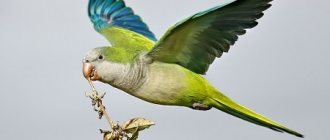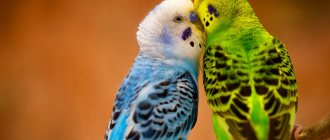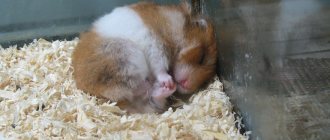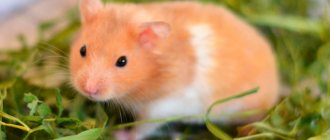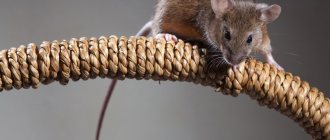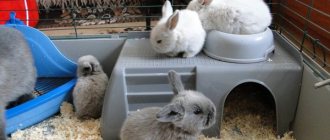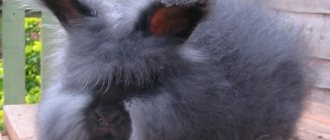According to statistics, only 5% of Russians who decide to have a pet opt for parrots. At the same time, in the homes of our compatriots, the overwhelming majority end up with not very exotic species of feathered pets.
The Rosella parrot, compared to its budgerigar, is a rare inhabitant of apartments and cottages. However, such a low prevalence of this species does not at all indicate the impossibility of keeping it at home. Rozella is an excellent parrot, very fond of human attention and communication. Such birds have strong empathy: they perfectly sense the mood of their owners and easily establish contact with them.
Description of the breed
These are small birds with a body length of about 30 cm. Mature individuals weigh about 100 grams. Dimensions and weight depend on the specific subspecies. A notable feature of rosellas is their wide tail, where 4 large and identical feathers stand out, located in its central part.
The main population of rosella is concentrated in Australia , but some subspecies can be seen on the island of Tasmania. The bird feels equally comfortable both on the ground, nimbly maneuvering through vegetation, and in the air.
If you create optimal conditions for Roselle in captivity, it will live for about 20 years. There are also references to long-livers who reached 50 years of age.
In the photo there is a penant rosella parrot:
Lifespan
The main feature that distinguishes classic Rosella parrots from other exotic poultry is their life expectancy. Unfortunately, many people have the erroneous opinion about the “fragility” of such animals, but in reality things are completely different.
The average lifespan of Rosella ranges from 15 to 20 years, of course, with proper care and the right diet.
The age of some individuals may exceed a quarter of a century - but this is rather an exception to the general rule. The Rosella parrot has a large number of positive qualities, including friendliness and sociability, which also affects everyday life and, accordingly, life expectancy.
Kinds
The first two species were described in 1788. A total of 6 species of birds were found and studied. Since 1792, the international scientific name of rosella is Platycercus.
Bird species:
- green rosella;
- red (ruby);
- pale-headed;
- yellow-cheeked;
- black-headed.
Variegated Rosella:
Where to buy and what to look for when buying
You can get yourself a colorful and sweet-voiced pet by visiting a specialized nursery (the best option), an advertised breeder, or a pet store.
Age
If the chick is less than six months old, you can safely buy it. An adult bird will be stressed for a long time after the move; it is too late to train it.
When buying a rozllu parrot, you should look at age
Floor
If the buyer's goal is training, it is better to take a male. When he gets used to it and acquires his first skills, he is given a pair. In this case, the female will also be very receptive, since her friend will definitely share knowledge with her when communicating.
Pet health
When choosing, it is very important to evaluate the appearance. The plumage should not have any bald spots, the general condition should be neat. On the beak and paws the color is even, the surface is smooth.
Behavior
Under no circumstances should you purchase a lethargic specimen. A healthy bird always reacts actively to any movement. It's bad if the parrot itches. This indicates one disease or another.
Intelligence and character of birds
The parrot easily adapts to new conditions, so it is quite suitable for keeping in houses and apartments. The rosella bird boasts singing abilities. The pet imitates the sounds of wildlife and the chirping of other birds.
The bird by its nature is cheerful, friendly and, like all representatives of the parrot family, curious. She easily makes contact with a person if he first treats her with a treat. However, Rosella is jealous. If there are other pets in the house besides her, then she will show obvious aggression towards them, demanding the owner’s attention.
It is also useful to read: Macaw Parrot
Why parrots are special:
Lifespan
On average, pets delight people from fifteen to twenty years, but there are long-lived individuals whose life will last up to thirty-five.
Intellectual abilities and skills
Everyone, without exception, loves music and easily repeats melodies, whistling them cleanly and rhythmically.
Rosella's skills and intellectual abilities
Breeders tell a lot of interesting things about rosellas. They:
- Excellent imitators, they imitate dogs, cats, humans, and accurately convey the creaking of doors and other sounds.
- They love communication and get used to their owner faster than others.
- They get along with everyone, except parrots of another species, with which they usually share territory, and conflict.
- They move quickly on the surface, fly short distances - a few strokes before the next landing.
- Music is closer to them because their voice is close to flute sounds, gentle, but the bass is not so easy to come by.
- They whistle and chirp.
- Chicks, accustomed to humans, learn quickly.
Life in the wild
In their natural habitat, rosellas prefer to settle in open landscapes. Birds feed on pears, apples, wheat and clover. That is why they cause a lot of trouble for local farmers. But at the same time they also bring benefits by eating insects and weeds.
Rosellas nest in the branches of large trees. But for lack of free space, they can arrange housing for themselves on poles, fences and even rabbit holes. Birds use almost anything and everything as building material for their nest, from branches to scraps of newspaper.
During the mating season, males attract females with original mating . The bird walks in a proud pose, spreads its tail, raises its wings and at the same time makes special sounds. As a response to courtship, the female adopts the pose of a chick asking for food. After the male feeds her, the pair can be called successful.
In the wild, the female lays about 4-5 eggs at daily intervals. Direct incubation occurs only after 2 eggs and lasts about three weeks. During this period, the female is tied to the nest, and food production falls on the shoulders of the male.
For reference! The young are born completely blind and slightly covered with white down. The chicks grow relatively quickly and leave the nest within a month. Parents can feed the young individuals for a couple more weeks, after which they drive them away.
Rosella lutino:
Habitat
The real homeland of parrots of this species is Australia and Tasmania. The birds are distinguished by strong adaptation qualities to forest life, and their natural food is the seeds of trees and shrubs, as well as nectar, berries and fruits.
Today, Rozella is present in most specialized poultry houses, and is also sold as a pet in any more or less large pet store. The Rosella parrot has a lot of positive qualities, including friendliness and sociability.
Buying a bird
You should only purchase exotic birds from breeders who have the appropriate documentation and positive reviews from the owners. Otherwise, there is a risk of getting a sick animal with an aggressive character. The optimal age for purchasing a rosella is 5 or 6 weeks. The older the individual, the more difficult it is to tame.
Signs of a healthy rosella:
- glossy sheen on feathers without bald spots;
- active chirping;
- no discharge in the eyes;
- paws and beak without whitish husk;
- skin without redness.
If the bird shows obvious signs of apathy, a clouded look, and when landing on a perch it lowers its wings, then most likely the parrot is sick. The breeder must provide information about the bird’s diet, its parents, and also indicate the optimal conditions for keeping it.
The bird is in good health if negative results are obtained for:
- helminthological studies;
- chlamydia;
- bacteriological research.
It would be useful to do a general blood test for biochemistry. From it, albeit indirectly, you can still judge the state of the parrot’s internal organs.
As for the cost, prices for young animals range from 6-17 thousand rubles, which depends on the subspecies, the availability of certificates of vaccinations and the health status of the pet. For example, for a green rosella you will have to pay about 7,000 rubles, while for a red one it is about 15,000.
Price
A Rosella parrot costs from 7,000 rubles. for the bird of the most popular and affordable species among buyers - common, oriental, or, as it is also called, motley.
The price for other types of parrots is already a large amount, which, as a rule, starts at 8,000–10,000 rubles. for one bird.
It is worth understanding that the faster and further the rosella needs to be delivered, the more expensive it will cost its future owner.
Life at home
Considering the Australian climate, the optimal conditions for keeping rosella are temperatures around 20-24°C with a humidity of 50-60%. The room must be ventilated at least once a day, even if there is bad weather outside. Stagnant air will affect your pet's health.
The bird must be able to fly at least once every 3 days. Her physical and psycho-emotional state depends on this. If the animal does not properly stretch its wings, it will simply become fat and at the same time experience stress.
Do you have a parrot?
Not really
What to feed the bird
Rosella is not picky about dry food, so she can be given any grain crops. It is imperative to include fruits, vegetables and herbs in your pet’s diet. Rosella's favorite delicacy is mealworms. She especially needs the latter during the period of feeding young animals. Grain can be given either dry or sprouted.
What to feed Rosella:
- canary seed;
- corn;
- millet panicles;
- pine nuts;
- Rowan;
- grain mixtures from oats, millet and millet.
The bird should not be fed with fatty, smoked and fried foods. Everything that goes into a parrot's feeder should not contain salt or sugar. The pet receives all these elements through fruits and vegetables.
Rosella also loves cottage cheese (low-fat), boiled eggs and cheese. The latter should be without spices, better than homemade. Citrus fruits should not be overused, because they contain a large amount of essential oils, which is undesirable for birds.
Cage, arrangement, toys for birds
Rosella's cage should first of all be spacious. In cramped conditions, the bird will immediately begin to become stressed. The optimal option is 150 x 70 x 70 cm. The shape can be rectangular or square. It is better to abandon the “skyscraper” format, because the parrot prefers to move in a horizontal plane rather than a vertical one.
As for the cage material, it is more practical to choose wood. Budget solutions made from plastic emit toxic fumes, especially in the warm season. If wood is not considered in principle, then you can choose good, as well as expensive synthetics marked “Eco” or “Hypoallergenic material”.
Rods made of copper alloys containing zinc or lead should be discarded. When oxidized, they release fumes that are toxic to your pet.
The cage must have the following accessories:
- perches (at least two);
- drinking bowl;
- feeder;
- swimsuit
If the bird lives alone and the owner disappears at work, then she will need toys. Otherwise, the pet will experience the pangs of loneliness, and this is a sure path to stress and apathy.
Minimum set of toys for a parrot:
- swing;
- ladder;
- mirror;
- beanbag;
- ball.
Care and maintenance
Just like other birds, the rosella must be kept clean. The cage must be thoroughly washed at least once a week. Every month, all accessories should be disinfected using specialized preparations.
The food should not be on the tray, so the feeder needs to be secured somewhere on the frame. Roselles love to splash in the water, and therefore a swimsuit is a must. It should be selected taking into account the size of the bird. Solutions for large birds, such as cockatoos or grays, are not suitable. A pet can drown in them. But there will be no return on bathing suits that are too small.
It is more advisable to use sawdust or calcined sand as a filler for the pallet. Scraps of newspapers or magazines contain paint, one of the components of which is lead. Metal can cause serious poisoning in a pet.
Hand Taming
For closer communication, the cage should be placed no higher than the level of the owner’s head. With every eye contact, the first thing the bird should hear is its name. You need to communicate in a calm tone, without making sudden movements.
Do not disturb your pet when it is eating, bathing or preening its feathers. If the bird hides in a corner at the sight of its owner, then direct contact is out of the question. A parrot should be around a person without fear.
The next step in hand training is giving treats. It is enough to put the animal’s favorite treat on your palm and offer it to it by sticking your hand into the cage. Not all birds make such contact the first time. It may take several tries. Also, you should not manipulate the feeling of hunger, otherwise the pet will develop unpleasant associations with the owner.
The last stage is to plant the rosella on your hand and take it out of the cage. Having become accustomed to a person, the bird will begin to show greater curiosity towards him. You can also use the treat trick here. Patience will be required, because the pet will not sit on your hand the first time.
Is it possible to teach a bird to speak?
The speaking abilities of rosellas are not as outstanding as those of grays or macaws. Even with intensive training, the maximum that can be squeezed out of a pet is a dozen words. But most often the vocabulary is limited to 4-6 words.
The optimal time for training is morning or evening . The room should be kept quiet and other household members or pets should be removed. Every confidently spoken word should be rewarded with a treat (in small quantities).
In some cases, it is more appropriate to use a recording of the owner’s voice with the necessary set of words or phrases. But it must be of high quality: without extraneous sounds or noise.
Breeding at home
Parrots willingly feed other people's young, so the male and female rosella can become foster parents for abandoned chicks. Birds will not mate if there are strangers in the cage or aviary: other pairs or single individuals.
A wooden house can serve as a nest: 25 x 25 x 40 cm with a hole diameter of 8 cm. If the female is preparing for laying, then the filler should be made of sawdust: sand in this case is not welcome. In the first days after birth, only the female feeds the young, and the male joins later.
Under favorable conditions, one clutch can contain from 4 to 8 eggs . After about a month, the chicks leave the nest, but the parents continue to care for them for the first two weeks. Sexual maturity occurs at approximately 15 months of age.
It is very difficult to distinguish a female rosella from a male, especially for an inexperienced breeder. Therefore, it often happens that beginners try to get offspring from same-sex birds. Here it is more advisable to consult an ornithologist or veterinarian.
Where does rosella live?
Photo: Rosella in Australia
The birthplace of the rosella, like many other exotic birds, is Australia. For a long time, this continent was cut off from the rest of the land, and this became the reason for the creation of a unique ecological system. In the last hundred years, birds have been released on several more islands, but only the Tasman Islands, whose climate is very similar to Australia, have taken root.
Birds prefer to settle in the shroud, on the edges of wild forests or in the Australian bush (large areas covered with tall bushes). Rosella's wings are not adapted for long flights, and therefore they do not mix over long distances, preferring to spend their entire lives in the same territory. What Rosella lacks the ability to fly over long distances, it makes up for with the ability to move quickly on the ground and even live in abandoned rabbit holes.
After people began to actively explore the Australian bush, parrots began to settle in parks and even in small gardens near cottages. Thanks to the intelligence of birds and their peaceful nature, parrots get along well with people and are not at all embarrassed by their presence.
Rosella reproduce well in captivity, live well at home, and the main requirement for their maintenance is high temperature. Birds are very thermophilic and frankly feel bad if the air temperature drops below +15 degrees.
Diseases and prevention
Like other members of the parrot family, rosellas are susceptible to a number of bacterial and infectious diseases. In addition to diseases, some birds suffer from parasitic insects: fleas, ticks and lice eaters.
Possible diseases:
- smallpox;
- tuberculosis;
- goiter inflammation;
- knemidocoptosis;
- pasteurellosis;
- psittacosis.
Tuberculosis and psittacosis pose a serious danger to humans. Therefore, at the first signs of disease, the animal should be shown to a veterinarian. Self-medication in such cases is unacceptable.
Disease prevention comes down to following four rules:
- Clean cell.
- Quality products.
- Maintaining an optimal microclimate for the parrot.
- No stress.
If the bird is kept clean, eats good food and fresh fruits and vegetables, and is not overcooled or overheated, then the risk of contracting any disease is reduced to almost zero. Serious stress immediately affects the health of the pet.
It is also useful to read: Diseases in budgies
Origin
Bright birds come from Australia, where the territories are spacious and sunny - all in the steppes and savannas.
Origin of the Rosella Parrot
Some representatives have chosen Tasmania and the islands nearby. They settle in city parks, in private and public gardens, and on farms. They love to communicate with people. It should be noted that this love is not always mutual.
Agricultural products are food for the chirping flock. The damage from merry parties is very great. They don’t care whether it’s fruit or wheat. The peasants are so dissatisfied that they forget about the other side of the coin. After all, it is the little birds that destroy voracious insects and seeds of all kinds of weeds on their lands. The benefits of birds are much greater than the harm.
Content Features
Before buying a parrot, you must decide how the bird will be kept in the future. Cages of medium and large sizes or a small poultry house or aviary are perfect for apartments.
It is best to keep rosella in a cage, poultry house or aviary.
Setting up a parrot cage:
- Small species of birds can be kept in cages that are one and a half meters high, 500 cm wide and about a meter deep.
- To make caring for your bird easier, you should purchase a cage with a retractable bottom.
- For a comfortable stay, various toys will help, as well as a house and a ladder.
When the cage is ready for use indoors, be sure to position it correctly. Rosellas do not tolerate heat and humidity well. The pet’s home must also be protected from the sun and drafts. In winter, it is worth considering artificial lighting to maintain daylight hours for eighteen hours.
With constant care and attention, birds can live up to thirty years. The parrot's intelligence is developed , and therefore he is very curious and tries to explore the world around him. Sometimes this causes birds to find themselves in unexpected and life-threatening situations. Before letting the bird go for a walk, you need to remove foreign objects that pose the greatest danger.
Varieties
Under the general name "Classical Rosella Parrot" there are many subspecies, each of which differs not only in color, but also in lifestyle and character. The following varieties of Rosella are distinguished:
In addition to the classic differences in basic coloration, body size, tail length, weight and behavior vary from species to species. For example, the spotted rosella has a calmer, more flexible character, while the ruby rosella is more active in communication and shows emotions.
Colorful appearance
These birds are distinguished by bright colors, combining from 7 to 10 shades and a scaly pattern on the wings. As a rule, the neck and chest of the bird are red, the belly is yellow or light green, and the tail is blue-blue. The Rosella parrot attracts attention with its wings, on the black feathers of which multi-colored scales seem to be painted, and on the sides there are blue stripes. Appearance makes it easy to distinguish a male parrot from a female. The latter are duller and have a smaller head.
The Australian Rosella parrot is distinguished from others by its unusually flat tail. In its center there are 4 feathers of equal length. To the right and left of them grow smaller feathers, and each subsequent feather, if counted from the middle, is always shorter than the previous one. Visually, such a tail resembles a fan, especially when the parrot opens it. The beak of these birds is rounded and rather weak.
Owner reviews
Rosella parrots love free space, so it is important to periodically let them out of the aviary or cage. This type of poultry is very friendly and tries to please the owner and his entire family. To avoid diseases, it is very important to monitor the temperature in the room, and the parrot feels most comfortable at 20-22°C . The feeder and drinking bowl should be made hanging, and the most convenient diameter of the bathtub for bathing is 20-22 cm.
However, having such a feathered pet is highly not recommended for those who have no experience in keeping parrots at all. After taming a rosella, it will need to be constantly given a sufficient amount of attention. Out of boredom and resentment, such a pet parrot becomes loud and extremely noisy, and is also capable of attracting the owner’s attention by damaging interior items. Many owners of such birds are faced with the fact that their pet “sharpens” its beak on any pliable surfaces in the room, including wires, expensive furniture and household appliances.
Tags: platycercus, parrot diseases, types of parrots, budgerigars, parrot health, parrots, rosella parrot, Birds, rosella, house keeping
Necessary equipment
Bath
This representative of birds loves to swim. It is better to meet him halfway and provide him with a container of suitable size with clean, warm water.
Humidity measuring device
However, damp air is harmful to parrots. You need to buy the appropriate device and ensure that the humidity in the room does not rise above sixty percent. If it crosses the required mark, another device will be required.
Heater
It is impossible to dry the air in the room and raise the temperature to the required twenty-five degrees without it.
Need a heater to maintain temperature
Lamp
People from the tropics need warmth and light. In our climate, the sun is clearly not enough, so owners purchase a special lamp for additional illumination in order to extend daylight hours.
Preferred diet
They enjoy eating mealworms, greens, vegetables, fruits, berries, and corn (it needs to be soaked). In order for your pets to exercise their beaks and improve their gnawing skills, it is better to immediately provide them with tree branches (only permitted ones). Otherwise, it’s the end of baseboards, wallpaper and, perhaps, electrical wiring.
Communication
They adapt to captivity quickly and easily. Communication with the owner is necessary, the birds almost immediately get used to it, they always feel the mood, try to help, and communicate.
Variegated rosellas are especially good in this regard. Good-natured, calm, friendly, unpretentious. Rosellas may not speak, but they sing very beautifully.
Communication with a parrot
